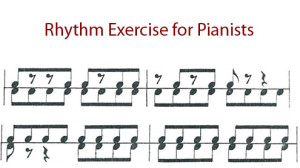 Not too long ago, if you had asked me to do any sort of improvising I most likely would have refused. Improvisation was not a part of my musical training growing up and was something I never really experimented with on my own. Most of my first exposures with improvisation came from learning to teach students to improvise in my undergraduate pedagogy courses. I am so glad that I’ve had some more experience with basic improvisation. This experience came in handy while I was attending the TMEA conference last month.
Not too long ago, if you had asked me to do any sort of improvising I most likely would have refused. Improvisation was not a part of my musical training growing up and was something I never really experimented with on my own. Most of my first exposures with improvisation came from learning to teach students to improvise in my undergraduate pedagogy courses. I am so glad that I’ve had some more experience with basic improvisation. This experience came in handy while I was attending the TMEA conference last month.
I scoured through the program looking for any sessions that would be piano related, since most of the conference is geared toward general music, band, or choir. Although the title of this session “Lessons from the Lab: Reaching the 21st-Century Learner,” was not clear that it was piano based, I recognized Martha Hilley, the presenter, as the author of Piano for the Developing Musician and Piano for Pleasure, so I made sure to make it to her session.
Dr. Hilley was such a fun presenter. She made sure to meet everyone in attendance before the session began and called us by name during the presentation. The main focus of her presentation was making rhythm drills fun and entertaining. She had several handouts with basic 8 measure rhythms, but instead of just having us clap she divided it up this way: alternating taps on legs for sixteenth notes, clap for eighths, snap for quarters, and stomp for half notes. Having to create the rhythm with these guidelines made for an entertaining challenge. Even for a room full of music teachers it sometimes became challenging. Another way she added interest was by having us tap along with various recordings accompanying us. These came from diverse styles including blues, movie soundtracks, and music from TV commercials. She suggested that you listen for music that can complement your rhythms but also challenge students to listen closely to the beat.
After we went through several rhythm drills, Dr. Hilley showed how to turn the rhythm patterns into an improvisation, using me as her duet partner (which was a surprise to me!). She asked if I had done any improvisation, and I said “a little,” but even with my small skill set, the improvisations were accessible and fun. She added a simple chord progression under the rhythms and had me improvise a melody in a five-finger pattern. We also switched parts, where I played a basic chord progression and she improvised.
All of her activities were much more entertaining than just clapping out rhythms. Adding a little bit of interest and added challenge can go a long way to turn a boring drill into a high-energy activity. How do you help your students become good rhythm readers? Do you have any other ideas to make it fun?
Also, I just returned from the MTNA Conference in Anaheim – be looking for some posts about sessions I attended while there!
Author: Spring
Spring Seals, NCTM, teaches 60 piano students ranging from age 3 to 70 in Fort Worth, Texas. She also serves as the Director of Certification for TMTA. She is passionate about helping teachers become more effective in their studios through professional development, new resources, and fresh ideas.
